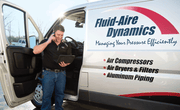Wondering how to increase the CFM for your compressed air system? Many people would like to get more airflow out of their compressor. The short answer is you can’t get more CFM from your system than your compressor is rated for. The longer answer? More airflow may not be what you’re really after - and there are some simple things you can do to get more out of your system. Possible ways to address CFM demand issues in your system include:
- Lowering the PSI of your compressed air system
- Fixing leaks and reducing waste
- Adding compressed air storage capacity
- Moving to a VSD compressor
- Adding a second compressor
- Making modifications to the existing compressor
Not sure which approach is right for you? Read on.
First Things First: What’s CFM, and How Does It Relate to Work?
First, let’s think about what people really mean when they ask, “how can I get more CFM from my air compressor”?
What Is CFM?
CFM stands for Cubic Feet per Minute and is a measure of airflow - how much air is moving through the system each minute. If your compressor is rated for 100 CFM, it can produce 100 cubic feet of compressed air per minute (at a particular pressure).
The CFM/Pressure Relationship
CFM is not a stand-alone measurement. In a compressed air system, airflow is always related to pressure, measured in PSI, or Pounds per Square Inch. So, a compressor is not just rated for “100 CFM”. It is rated for a certain airflow at a particular pressure - for example, “100 CFM at 100 PSI”. As you lower the pressure of the system, less CFM is needed to maintain that pressure. If you raise the pressure of the system, more CFM is needed to maintain the additional air pressure. And all of the tools and processes that are using air-cylinders, air tools, blowguns, etc. - are using more CFM, too.
The relationship between pressure and CFM will depend on what kind of compressor you have.
- In a variable speed drive (VSD) compressor, CFM and PSI are inversely related to each other. Increasing pressure in a variable speed compressor will reduce the available CFM, while decreasing the pressure will increase the available CFM.
- Fixed-speed compressors always produce the same amount of air (flow). You can’t increase the CFM without providing more horsepower (HP). You can’t lower CFM, either - if you use less air, the compressor simply spends more time unloaded vs. loaded. What does change when you raise or lower the pressure is how much energy is required to maintain the pressure. The higher the pressure, the more time the compressor spends making air, and the higher the energy used.
CFM, PSI and Work

When people say they need more CFM from their air compressor, sometimes what they really mean is they want their system to do more work. Work, in physics terms, is a measure of energy transfer through the application of an outside force that causes some kind of action, such as movement of an object. In your compressed air system, the air supplies the outside force, and the work is the action powered by air - for example, causing pistons or conveyors to move, spinning a rotor, driving a nail through a pneumatic nail gun, etc.
By lowering plant pressure, it may be possible to get more work out of the CFM your compressor is producing. The higher the pressure, the faster pneumatic tools and equipment will use air. That means air tools, cylinders, blowguns, and other air-operated equipment will use more CFM at higher pressures. But that extra CFM isn’t doing more work - you’re just using more energy to perform the same work. To get more value from the CFM the compressor generates, try to find the lowest pressure at which the plant can operate; this will increase available CFM and reduce the overall energy consumed.
Many plants are operating at higher pressures than they really need for their tools and equipment. If you are operating at 120 PSI but only need 100 PSI, or operating at 100 PSI and really only need 90 PSI, reducing the pressure will allow you to do the same amount of work with less energy. For every 2 PSI you lower the pressure, you’ll save about 1% on your compressed air energy bill. Read more to find out if this strategy is right for you: Reduce Plant Pressure to Save Money and Energy.
That means that one answer to the “how do I get more CFM from my compressor” question is to lower the PSI of your system. While you’re not actually getting “more CFM”, you’re getting more value out of the CFM your compressor can produce. This may address your CFM demand issues if you just need a little more power for daily operations. If you need a lot more power out of your compressed air system, you’ll have to look for other answers.
Are You Wasting CFM?
One place to look: how much of your air is being wasted? If you have leaks in your compressed air system, a lot of your potential power is being lost. Air leaks cause a loss of pressure between the compressor and the end of the line where air is needed. To compensate for this pressure drop, plants may have to raise the overall PSI of their system to ensure that pressure at the point of use does not drop below the rating for the equipment. And just as air tools use more air at higher pressures, leaks lose air faster, too-further reducing the CFM available for manufacturing processes.
Fixing air leaks ensures that every precious cubic foot of air stays in the system where it belongs so it can do work. Fixing leaks and reducing air waste also saves money and energy: you need less airflow when it is all being used effectively.
You’ll also want to look at other causes of pressure drop in your system. For example, if your plant compressed air piping or hoses are too small, you’ll experience pressure drop due to the constriction. If the pipes cannot accommodate the flow to get enough compressed air to your equipment, pressure may need to be increased to get the job done. Increasing pipe or hose sizes will reduce pressure drop and decrease the pressure needed from the compressor to perform the task. Loaded inline filters are another cause of pressure drop. An efficient compressed air system that minimizes pressure drop will let you get the most out of your available CFM.
Meeting Intermittent or Variable CFM Requirements
Another consideration when looking for more CFM from your compressed air system is whether you need additional airflow continuously or just intermittently. If your demand for air is intermittent or variable, you may benefit from adding storage or moving to a variable-speed drive compressor. Another option would be to add another secondary air compressor.
Adding Storage to Your Compressed Air System
If your demand cycles are punctuated by short, intermittent bursts of high demand - for example, for blow-off, to operate a particular hand tool, etc. - adding more air storage to your system may help you reduce your overall CFM requirements.
An air receiver tank acts like a battery in your compressed air system, storing energy (compressed air) until it is needed. Instead of increasing the CFM of your whole system to meet your peak demand, you can draw on this stored supply. This can vastly increase the efficiency of your system and allow you to get by with lower overall CFM.
Switching to a VSD Air Compressor
If your demand is highly variable - but not necessarily characterized by very short bursts - you may benefit from a variable speed drive (VSD) air compressor. It is important to remember that a VSD compressor cannot provide more CFM than its maximum rating. So, if it is rated for 100 CFM at 100 PSI, you’re not going to get more than 100 CFM at that pressure. However, if your demand is normally 70 CFM, but you have occasions when you need up to 100 CFM, a 100 CFM variable speed may be a better choice than a 100 CFM fixed speed. Another advantage of a variable speed compressor is that it is easy to change the air pressure discharge; increasing the pressure will reduce the CFM of the machine, while decreasing the pressure will increase the CFM. Finding the optimum pressure for your facility is easy, because pressure can be increased or decreased 1 PSIG at a time.
A VSD compressor can provide significant energy savings. How? A VSD compressor ramps motor speed up and down depending on actual demand for air. So, when you are using less air, it’s working less hard - and using less energy. In contrast, a fixed-speed air compressor has a fixed CFM: it is either loaded or unloaded - and it’s still using some energy, even when unloaded.* With VSD, the compressor can adjust the CFM of your system to your demand, up to but not exceeding its maximum rating.
Adding a Backup Compressor

Another way to add CFM to your compressed air system, for either intermittent or continuous use, is to simply add another compressor. A secondary compressor is usually the same size or smaller than your primary compressor. If your need for additional CFM is variable - perhaps by shift or season - the secondary compressor can be powered off when it is not needed and turned on when CFM needs are high. If it is the same size as the primary compressor, it can also function as a redundant backup to your primary system. On the other hand, if you just need a little extra oomph in your system occasionally, a small secondary compressor may just do the trick.
Modifying an Air Compressor to Get More CFM
But what if you want to get more CFM out of your existing air compressor without lowering plant PSI? Is it possible? Well, yes…but not without making significant modifications to the system. You can’t just change some settings to increase CFM beyond the maximum the system is rated for. Getting additional CFM out of your compressor will require upgrading the compressor pump and motor - that is, adding more horsepower to the compressor. This is a major expense for a large industrial air compressor: essentially, you’re rebuilding the compressor to turn it into one with a higher CFM rating.
Is it worth it? Possibly…but in most cases, you’re better off investing in a new, larger compressor (perhaps a VSD) or adding a secondary compressor. If your air compressor doesn’t meet your CFM needs, you may be able to sell it used and put that money towards a newer, larger compressor. And if you are switching from a fixed speed to a VSD, your energy company may help pay the bill.
Need More CFM? Talk to the Compressed Air Experts at Fluid-Aire Dynamics
It’s not always easy to know the best, most cost-effective way to get more CFM out of your compressed air system. Fluid-Aire Dynamics can help - whether that means adding a compressor, upgrading to VSD, fixing leaks, adding storage or simply reducing PSI. Contact us, and we can perform a compressed air system audit and help you determine the best path forward to ensure your CFM needs are met.




